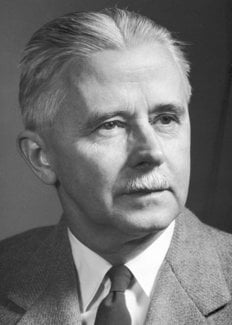Keffer Hartline
Biographical

Haldan Keffer Hartline was born in Bloomsburg, Pennsylvania, on December 22nd, 1903. His parents were teachers there in the State Normal School (now Bloomsburg State College) where he received his early education. His father, Daniel S. Hartline, was Professor of Biology, but a man whose wide interests also included Astronomy and Geology. It was through his father that Keffer became interested in Natural Sciences.
Keffer Hartline attended Lafayette College in Easton, Pennsylvania, graduating in 1923 (B. Sc.). His college teacher of biology, Beverly W. Kunkel, encouraged him to undertake research; his first scientific paper concerned visual responses of land isopods. Summers at the Marine Biological Laboratory at Woods Hole added to his biological training; there he was especially influenced by Jacques Loeb, Selig Hecht, and Merkel H. Jacobs.
In the autumn of 1923 he entered the Johns Hopkins School where he was encouraged to continue his research interest in vision in the Department of Physiology under E. K. Marshall and C. D. Snyder. Dr. Snyder let him use his Einthoven string galvanometer with which Hartline undertook the study of the retinal action potential using frogs, decerebrate cats and rabbits. He learned to obtain electroretinograms from intact animals, and recorded clearly recognizable retinal action potentials from human subjects. He also used intact insects for quantitative studies.
After receiving his M. D. from Johns Hopkins in 1927 a National Research Council Fellowship (Medical Sciences) enabled him to study Mathematics and Physics so as to strengthen his background for future biophysical research. He spent two years in the Physics Department of Johns Hopkins taking courses and working as a student in the laboratory of A. H. Pfund; F. D. Murnaghan was his teacher of mathematics. In 1929 he received an Eldridge Reeves Johnson Traveling Fellowship from the University of Pennsylvania, for a continuation of his studies in Physics. He spent one semester with W. Heisenberg‘s seminar group in the University of Leipzig and two semesters attending lectures by A. Somerfeld at the University of Munich.
In the spring of 1931 Hartline returned to the United States taking a position at the University of Pennsylvania, in Philadelphia, in the Eldridge Reeves Johnson Foundation for Medical Physics, which was under the directorship of Detlev W.Bronk. This was the start of a stimulating association with Bronk, which has continued to the present time.
At the Johnson Foundation Hartline began his studies on the activity of single optic nerve fibers in the eye of the horseshoe crab, Limulus, recording the responses of receptor units under various conditions of stimulation and adaptation. In the mid 1930’s he undertook the single fiber analysis of the optic responses of the vertebrate retina, principally in the eye of the frog. In the early 1940’s Hartline worked on problems of night vision in human subjects. In 1940-1941 he was Associate Professor of Physiology at Cornell Medical College in New York City, but returned to the Johnson Foundation where he stayed until 1949.
In 1949 Hartline accepted a position at Johns Hopkins University as Professor of Biophysics and Chairman of the Thomas C. Jenkins Department of Biophysics. There, he began with his colleagues work on intracellular recording from receptor units in the Limulus eye. It was at that time that he took up the study of the inhibitory interaction in the Limulus retina, begun briefly several years before. In 1953 he accepted his present position as Professor at the Rockefeller University (then the Rockefeller Institute). Hartline was joined there, in 1954, by Floyd Ratliff and they have continued to the present time collaboration in their joint laboratory on the study of receptor properties and inhibitory interaction in the eye of Limulus, and on related aspects of visual physiology.
Hartline was awarded the William H. Howell Award (Physiology) in 1927; the Howard Crosby Warren Medal (Society of Experimental Psychologists) in 1948; an Sc. D. (hon.) from Lafayette College, 1959; the Albert A. Michelson Award ( Case Institute of Technology) in 1964; a degree of LL. D. from the Johns Hopkins University in 1969; and an hon. D.Sc. from the University of Pennsylvania in 1971; the Lighthouse Award in 1969; hon. M.D. Albert-Ludwigs University, Freiburg im Breisgau, 1971.
Professor Hartline is a Member of the National Academy of Sciences; Foreign Member of the Royal Society (London); Member of the American Academy of Arts and Sciences; Member of the American Philosophical Society, American Physiological Society, Optical Society of America, Biophysical Society, etc.
In 1936 Haldan Keffer Hartline married Elizabeth Kraus, daughter of the eminent chemist C. A. Kraus. At that time she was instructor in Comparative Psychology at Bryn Mawr College. They have three sons, Daniel Keffer, Peter Haldan, and Frederick Flanders. Daniel Keffer and Peter Haldan have positions in neurophysiology in the University of California at San Diego; Frederick Flanders is still engaged in graduate studies in the biological sciences.
This autobiography/biography was written at the time of the award and first published in the book series Les Prix Nobel. It was later edited and republished in Nobel Lectures. To cite this document, always state the source as shown above.
Keffer Hartline died on March 17, 1983.
Nobel Prizes and laureates
Six prizes were awarded for achievements that have conferred the greatest benefit to humankind. The 14 laureates' work and discoveries range from quantum tunnelling to promoting democratic rights.
See them all presented here.
